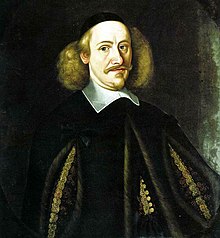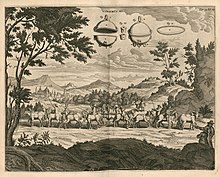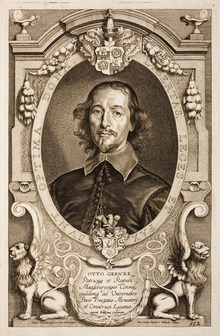Otto von Guericke

Otto Guericke , from 1666 von Guericke (pronunciation and original spelling: Gericke [ ˈgeːʁɪkə ]) (* 20 November July / 30 November 1602 greg. In Magdeburg ; † 11 May July / 21 May 1686 greg. In Hamburg ) was a German politician , lawyer , physicist and inventor . He is best known for his experiments on air pressure with the Magdeburg hemispheres .
Life
Guericke is the only son of the marriage of Hans Gericke (1555-1620), council chamberlain and later mayor of Magdeburg, and the wealthy patrician daughter Anna von Zweydorff from Braunschweig (1580-1666).
One of his many connections to Braunschweig is that Otto von Guericke received a study scholarship for a period of six years from Anna von Zweydorff's maternal grandfather, Conradus von Plauen (Plaue), "the city of Braunschweig's 50-year-old senior secretary" in his varied scientific training would undoubtedly have been an advantage.
He studied from 1617 to 1619 at the University of Leipzig at the artist faculty , for a few weeks at the University of Helmstedt and studying law at the University of Jena from 1621 to 1623 and from 1623 to 1624 in Leiden law and fortress construction .
This was followed by an educational trip (or cavalier tour) through England and France. In November 1625 he was back in Magdeburg. On September 18, 1626 he married Margaretha Alemann , daughter of the councilor Jacob Alemann. With her he had three children: Anna Catharina (born August 1627, died 13 October 1627), Otto Junior (born 23 October 1628, died 1704) and Jakob Christoph (born 1630, died 1632). In the same year he was elected to his hometown council. As councilor he assumed the function of a builder and in the case of defense in 1629 and 1630/1631 that of a patron. After the city was destroyed in 1631 , he worked as a fortress construction engineer in Erfurt and from 1632 in Magdeburg in the Swedish service. From 1636 to 1646 he also worked in Magdeburg in the Electoral Saxon service. In 1646, after initial diplomatic successes, he was elected one of the four mayors of the old town of Magdeburg . In 1652 (seven years after the death of his first wife) he married Dorothea Lentke, the daughter of his colleague Steffan Lentke . This marriage remained childless.
From 1642 to 1663 he was on diplomatic missions on behalf of the city; this also includes participation in the negotiations on the Peace of Westphalia , the Execution Day in Nuremberg 1649/1650 and the Reichstag in Regensburg 1653/1654.

From around 1645 onwards, stimulated by the discussion on astronomy, he carried out investigations into pneumatics , for which he was to become famous. A lively correspondence began as early as 1656 with the professor of philosophy and mathematics in Würzburg. Caspar Schott published his work Mechanica hydraulico-pneumatica in 1657 , which includes the appendix New Magdeburg Experiment . This is the first publication by Otto von Guericke. In 1664 Caspar Schott published another work, Techica curiosa in Würzburg. It contains the second publication by Otto von Guericke. In 1663 he completed the manuscript of the Experimenta nova… , but did not print it until 1672 in Amsterdam.
On January 4, 1666, he was ennobled by Emperor Leopold I , adding a u (Otto von Guericke) to his surname so that it could also be pronounced correctly by foreign diplomats, since French was used as the emerging language of diplomats at this time and thereby his name was pronounced the same in French and German.
In 1676 he refused to take over the mayor's office on a rotating basis for health reasons. In 1678 he was declared "pro emerito" by the council. In 1681, when the plague broke out in Magdeburg, he moved to live with his son in Hamburg, after his honorary tax exemption in Magdeburg had been canceled. Guericke died in Hamburg in 1686. After his bones had been transferred to Magdeburg, he was buried on July 2, 1686 in the Johanniskirche in the Alemann / Guericke crypt. During the Napoleonic period, when the church was turned headlong into a hospital, the crypt was removed. The bones were buried in large graves in front of the city gates. The crypt can still be visited today. The tombstone of his first wife was found a few years ago in the Johanniskirche.
power
His main scientific achievement is the establishment of vacuum technology .
He invented the piston vacuum air pump in 1649 and the air balance in 1650 , examined the properties of the (partial) vacuum in a large number of experiments and created applications such as the lifting experiment and the wind socket . He was able to show that light penetrates the vacuum, but not sound .
In public he demonstrated the power of air pressure with spectacular experiments. He received special attention in 1654 when he was on the Haidplatz in Regensburg on the occasion of a Reichstag in the presence of Emperor Ferdinand III. and had many princes perform spectacular experiments on the effect of air pressure. In the summer of 1657, Guericke had put two large hemispheres (¾ Magdeburg cubits ) made of copper ( Magdeburg hemispheres ) together using a seal and pumped the air out of the inside. Then eight horses were harnessed to each hemisphere, one after the other, which they were supposed to tear apart, but this did not succeed. When the balls were filled with air again, they fell apart on their own. In another attempt, Guericke had a cylinder with a movable piston set up. A rope was attached to the piston, which ran over a pulley and was held by 50 men. When Guericke sucked the air out of the cylinder, the men could not prevent the piston from lowering because the atmospheric air pressure was stronger against a vacuum. That was the momentous invention of his hoist.
With his experiments, Guericke confirmed conclusions that Blaise Pascal had drawn ten years earlier from the experiment Void in Void . Furthermore, his experiments and inventions showed that nature knows a vacuum. The “horror of the void” ( Horror Vacui ) postulated by Aristotle was thus refuted.
In 1632 he made a full-scale city map of his hometown. Guericke used a barometer for weather forecasting and was thus a pioneer in meteorology . He also built a 10 m high water barometer on Magdeburg City Hall. The forecast of a storm is known for 1660, which then also occurred.
Guericke is also credited with new discoveries in the field of electricity . This is based on experiments with a sulfur ball, first published by him in 1672, in which he tried to prove the cosmic forces postulated by him. Here Guericke describes, among other things, attraction and repulsion phenomena that we understand today as electrical phenomena. His experimental setup is therefore sometimes described as the first electrifying machine. Such ascriptions are problematic, however, because Guericke saw other forces at work here, forces that we no longer know today. It is therefore doubtful whether Guericke gained knowledge of electrical relationships from the observed phenomena.
He also dealt with astronomy and was the first to assert that the time of the return of a comet must be determined.
In 1678, Guericke constructed a unicorn from bones that had been found near Quedlinburg in 1663 .
Appreciations
- The University of Magdeburg bears his name as Otto von Guericke University Magdeburg , as does the previously existing Magdeburg University of Technology . Since 1831 the mayors of Magdeburg and the city appealed to their great son. His bust was erected in the Walhalla near Regensburg in 1842 .
- The Luftpumpentaler from 1702 are the first to depict the attempt to separate the Guericke hemispheres and the first ever to refer to Otto von Guericke. Although he was internationally famous, there was no coin or medal dedicated to him or his inventions during his lifetime.
- The “Municipal Higher Trade School, Secondary Secondary School”, founded in 1868, was called Otto-von-Guericke-Gymnasium from 1879 until it was closed in 2007
- In 1907 Guericke received his own memorial near Magdeburg City Hall. His hometown Magdeburg and many other German cities named central streets after him in his honor.
- The Otto von Guericke Society and Foundation maintain his legacy. In the Otto von Guericke Museum in Lukasklause , Magdeburg, his experiments can be reproduced true to the original.
- The Guericke lunar crater was named after him.
- In 2000 the asteroid (11537) Guericke was named after him.
- In 1936 the Deutsche Reichspost issued a special stamp to mark the 250th anniversary of Otto von Guericke's death
- In 2002, Deutsche Post AG issued a special stamp for his 400th birthday. Ten years later, the Google search engine showed a Google Doodle , which was based on the illustration by Caspar Schott shown above.
- The Working Group of Industrial Research Associations (AiF) is nicknamed "Otto von Guericke" and awards the Otto von Guericke Prize .
- In 2002, the large sculpture created by Thomas Virnich for the Magdeburg hemisphere experiment was inaugurated in Magdeburg.
- In 2016 a square was named after him in the industrial area of Hanau .
Works
- Ottonis de Guericke: Experimenta Nova (ut vocantur) Magdeburgica de Vacuo Spatio . Vol II / 1/1, Waesberge, Amsterdam 1672; Facsimile, Stekovics, Halle ad Saale 2002, ISBN 3-89923-015-9 ; Digitized version of the Herzog August library ; Digital copy ( memento from October 25, 2014 in the Internet Archive ) from the library of the Ohm University of Nuremberg (PDF; 30.5 MB)
- Otto von Guericke: New "Magdeburg" experiments on empty space . Ostwald's classics series, vol. 59. Thun, Frankfurt / M. 1996, ISBN 3-8171-3059-7 ; Translated by: Ottonis De Guericke Experimenta nova Magdeburgica de vacuo spatio , Waesberge, Amsterdam 1672.
- Otto von Guericke: Otto von Guericke complete edition . Stekovics, Halle ad Saale 2005, ISBN 3-89923-089-2 ; Vol. II / 2/3/1: Otto von Guericke: Relationes Derer to the Lord Mayor Otto von Guericken, because of the common city of Magdeburgk, 18th year after another, stated and entrusted 17 different, partly even long-lasting, deportations (1642 to 1660 ) . Translite. by Ditmar Schneider, Lat. Translated by Rudolf Engelhardt.
- The siege, conquest and destruction of the city of Magdeburg on 10./20. May 1631 . Voigtländer, Leipzig 1912 (digitized version)
literature
- Klaus Liebers: The miracle of vacuum. Experiments that made history. Verlag epubli, Berlin 2016, ISBN 978-3-7375-9188-1 .
- Klaus Liebers: Otto von Guericke and the vacuum adventure . Publisher epubli.de, Berlin 2015, ISBN 978-3-7375-3662-2 .
- Klaus Liebers: Otto von Guericke - a German Galileo. 330th year of death of the great experimenter. In: Naturwissenschaftliche Rundschau , No. 820 (2016), pp. 515–523.
- Fritz Krafft : Otto von Guericke . In: Exempla historica. Epochs of World History in Biographies, Vol. 27. Fischer Taschenbuch: Frankfurt / Main 1984, pp. 221–256.
- Literary Society Magdeburg e. V. (Ed.): Otto von Guericke. The biography of a literary figure . In: Monumenta Guerickina , issue 11/12, Magdeburg 2004.
- Eugen Lommel : Guericke, Otto von . In: Allgemeine Deutsche Biographie (ADB). Volume 10, Duncker & Humblot, Leipzig 1879, p. 93.
- Matthias Puhle: The world in empty space. Otto von Guericke 1602–1686 . Deutscher Kunstverlag (exhibition catalog, 1st edition), Berlin / Munich 2002, ISBN 3-422-06374-9 .
- Hans Schimank: Guericke, Otto von. In: New German Biography (NDB). Volume 7, Duncker & Humblot, Berlin 1966, ISBN 3-428-00188-5 , pp. 283-286 ( digitized version ).
- Ditmar Schneider: Monumenta Guerickiana . Issue 9/10 (Festschrift for the Guericke year 2002 with biographical dates), Magdeburg 2002; ISSN 1439-8346 ; has been published annually since 1995.
- Ditmar Schneider: Otto von Guericke: a life for the old city of Magdeburg; using contemporary documents and images . Teubner, Stuttgart / Leipzig 1997, ISBN 3-8154-2515-8 .
Web links
- Literature by and about Otto von Guericke in the catalog of the German National Library
- Report on the hemispheres in Braunschweig
- Deutsches Museum Munich - The famous hemispheres in the Deutsches Museum
- Ersch , Gruber : Allgemeine Encyclopädie der Wissenschaften und Künste T. 96 P. 190
- Digitized works by Guericke ( Memento of July 21, 2011 on the Internet Archive ) - SICD of the Universities of Strasbourg
- Materials about von Guericke of the Otto von Guericke Society
Individual evidence
- ↑ a b Joachim Lehrmann : Fricke van Twedorp / from Zweydorff - From the life of a patrician and pelvic worker-entrepreneur of the Brunswick Neustadt - 1400. In: Brunswick native, 2016, Vol I, pp 8-19..
- ↑ a b Walther Kiaulehn : The iron angels. A history of machines from antiquity to the time of Goethe . Berlin, 1935, Deutscher Verlag, reissued in 1953 by Rowohlt Verlag
- ^ Karl Bauer: Regensburg Art, Culture and Everyday History . 6th edition. MZ-Buchverlag in H. Gietl Verlag & Publication Service GmbH, Regenstauf 2014, ISBN 978-3-86646-300-4 , p. 297 f .
- ↑ Otto von Guericke: New (so-called) Magdeburg experiments on empty space (Experimenta nova (ut vocantur) Magdeburgica de vacuo spatio, Amsterdam 1672, German), translated by Hans Schimank, 2. durchges. Ed., Ed. v. Fritz Krafft , VDI Verlag, Düsseldorf 1996. See in it the 4th book (The cosmic forces ...), in which the sulfur ball experiment is described in the 15th chapter. ( books.google.de )
- ^ Heathcote, NH de V .: Guericke's sulfur globe. Annals of Science 6 (1950), pp. 293-305.
- ↑ Information from the Deutsche Post AG Philately Collector Service ( Memento from August 25, 2010 in the Internet Archive )
- ↑ Otto von Guericke's 410th birthday. Google Doodle from November 20, 2012
- ↑ AiF e. V. , price
- ↑ Hanauer Anzeiger from February 6, 2016
| personal data | |
|---|---|
| SURNAME | Guericke, Otto von |
| ALTERNATIVE NAMES | Gericke, Otto (maiden name) |
| BRIEF DESCRIPTION | German inventor and politician |
| DATE OF BIRTH | November 30, 1602 |
| PLACE OF BIRTH | Magdeburg |
| DATE OF DEATH | May 21, 1686 |
| Place of death | Hamburg |




